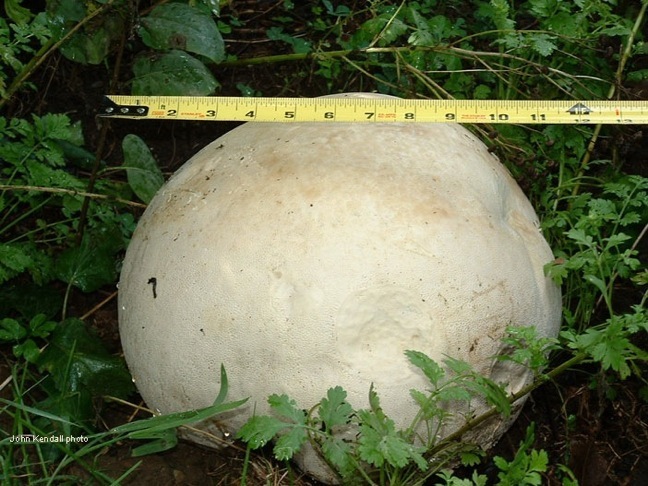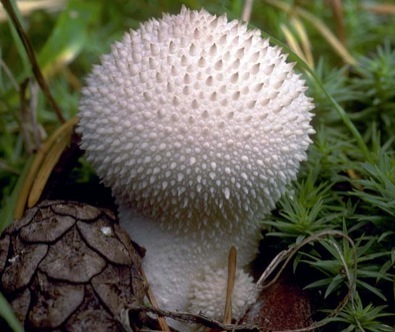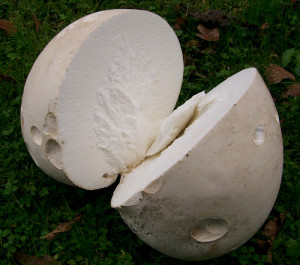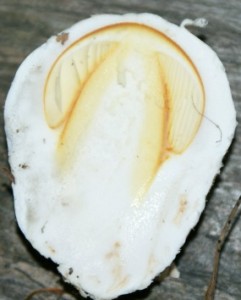
Giant puffball
Do not eat any mushroom without checking in person with a local, live, mushroom collector.
Lycoperdon perlatum: Edible Puffballs
I avoided mushrooms for a long time, and with good reasons. Some of them are on par with cyanide and arsenic and can melt your liver. Worse, unlike most plants that let you know within the hour you have erred, mushrooms can wait several days. So when I decided to learn about mushrooms I went with the classic first: The puffball, Lycoperdon perlatum (lye-ko-PAIR-don per-LAY-tum) also called the Common Puffball, the Gem-studded Puffball and the Devil’s Snuff Box.

Most of us learned about puffballs when were were kids, finding them in the spore stage and flattening them into a puff of spore smoke. Remember the brown cloud that used to spray out from under our foot? Then it will come to no surprise to you that the genus name is Lycoperdon, which plainly said means “wolf fart.” As for the species name, perlatum means pearl-like and the puffballs often in clumps like a bunch of pearls.
While perhaps the puffball is the least complicated mushroom to identify, there are things you must absolutely look for and here is the reason why. Two other mushrooms can resemble it, both fatal. The look alikes are young Sclerodermas and Amanitas.
Always cut your “puffball” from top to bottom and examine the inside. A young Sclerdomera will be round and white inside like a puffball but the white flesh will be hard. The white flesh of the puffball is marshmallow soft. The young Amanita can be round and white inside like a puffball but it will show the outline of the yet unopened mushroom. The Sclerdomera has caused deaths and the Amanita is nearly always fatal without medical attention and often fatal with medical attention. See photos below.
Never take for granted you have a puffball. Always cut each one open vertically, top to bottom, and make sure it is one solid soft white mass inside with no outline. You should make sure the inside is pure white, never dark, and that the outer skin of the puffball is thin. If the inside is dark from the start and the outer skin is thick you probably have Scleroderma, one of the earth balls.
With smaller puffballs you must make sure the entire fruiting body is homogeneous, consistently a texture of marshmallows. You should slice down the center of every puffball to make sure there is not a pre-formed mushroom inside. If so, it is likely to be an immature form of the death angels, Amanita bisporigera, Amanita virosa, and Amanita verna. They are all deadly. Do NOT eat them. In fact they are quite cruel. Feeling better after the first attack is the sign of impending death. Ninety percent of all mushroom fatalities involve Amanitas.
On the other hand, there are no poisonous puffballs, and most forms are edible when young. Though as with everything, some individuals are allergic to them. Giant puffballs, that can grow as big as a basketball, are not only edible but mighty difficult to mis-identify. They are edible as long as the flesh is white and soft.
Green Deane’s “Itemized” Plant Profile
IDENTIFICATION: Round or pear shaped mushroom up to 3.5 inches tall, tapered base. Outer surface is composed of conical spines and irregular-shaped whitish to cream-colored warts that become brownish with age. They eventually fall away leaving pits or net-like scars on the spore case beneath. The spore case is divided into an upper fertile portion (gleba) and a sterile, stalk-like base, tan to pale brown or grayish brown, darker in age, thin-walled, papery, gleba white and fleshy at first becoming olive-brown and powdery as spores mature. Base sterile, chambered, taking up about a third to one half of the fruiting body. Spores round, minutely warted, pale yellow (yellow-brown to olive-brown in mass.)
TIME OF YEAR: Nearly year round in warm climates, summer fall in northern climates.
ENVIRONMENT: Usually in groups, often in clusters on ground, sometimes on well-decayed wood, in forests or open areas.
METHOD OF PREPARATION: Edible when immature and entirely white inside and soft. Can be sauteed in butter or added to soups and stews. Cut every puffball vertically and check to see that there is no outline of a mushroom inside.





Hi, I love your site. How come you don’t include any recipes? Battered and fried! or perhaps lightly sauteed in butter with garlic? Any reason you do not touch on any other fungus? Porcinis? Morchella? Oysters? or maybe I missed these articles.
Actually I have included a lot of recipes, though not too many regarding mushrooms because while I know mushrooms I don’t cover them. On the lower right hand side of the home page there is a list of categories. There you will find “recipes” click on it and you will see a list of all the articles that include recipes.
I enjoy reading everything in your posts.I’d like to try and pick mushrooms,but not sure of myself.I wanted to try and buy shitake mushroom spores.To grow my own. Seems like a lot of work, which I don’t mind. But have a hard time trying to find oak logs to plant them in. Have a blessed day.
Funny story about those shitake logs, Pamela. We’d forgotten about ours and when we were packing to move homes, opened up the cupboard in which we’d left it to grow. The entire inside of the cupboard was lined with shiitake mushrooms. A little bit too successful. We quietly closed the door and left it as-is.
That is very funny about leaving the mushrooms in the cupboard of home you were moving from. ?
Thanks for this post! I’d love to try wild mushrooms, but don’t trust myself to recognize anything except a puffball. If you cut a mushroom open and find that it’s an Amanita, how carefully do you need to clean your knife before cutting another mushroom? Wipe it off, rinse it with a dribble from your waterbottle, or take it home and bleach it?
I have eaten puffballs for a few years, always the small ones. Recently I ate three very small (smaller than a dime) puffballs (and, yes, I can identify them, in fact I cut one open to show a friend) BUT I experienced a little nausea an hour later – same thing happened with meadow mushrooms – I seem to have acquired a rejection of these wonderful eatables!! I know that one can go from being unaffected by poison ivy to being affected – I guess the same thing happens?
Ever heard of this with anyone else?
well I didn’t know one could go from NOT being allergic to poison ivy to being allergic to it… ive never been allergic to it nor poison oak or sumac but my kids are ,,, I wonder what it is in our bodies that makes a person Not allergic to these things ?
You can “become” allergic to anything any time in your life. It can be something you’ve been exposed to numerous times in your life without a reaction, then all of a sudden you do react to it.
I was given a strong antibiotic at the hospital and after that I suddenly had trouble with many foods that had been common fare for me, so that is one way our digestive tract takes a beating. Also even with poison ivy some native peoples eat tiny leaves of poison ivy each year to get a resistance to the reaction. (every day for a couple weeks I think) Not sure if it works that way with mushrooms but if all you get is a slight nausea it might be worth a try.
This comment is separate from mushroom consumption. A strong antibiotic can destroy a lot of good bacteria in the gut leading to a lot of gastric issues. Pre- and probiotics can help restore your previous flora. It is as if the pre- and pro become placeholders as your own bacteria array recovers.
I’m one that was never allergic to poison ivy until the last few years, [I’m 77] I still pull it out of my flowers but get blisters, etc. on my arms. It’s hard to remember to be careful around it because of never having problems before.
Eventually everyone become allergic to poison ivy.
I used to be immune to poison ivy. In my late 40’s I suddenly became allergic to poison ivy. Because I hadn’t previously been allergic friends would call me to remove theirs if they got it and I never took precautions to protect myself. Because of this my first reaction was bad; all over my arms and legs as well as from reaching under my shirt to scratch, wiping sweat from my face, etc. I have a few scars from it to this day from the scratching and the fact that it took me so long to realize why I was itching so much. Dr said you can become allergic to something at any point in your life.
Yes, my husband developed an allergy to morel mushrooms! He used to pick them and eat them every spring and now if he just touches one, he will be in the bathroom for the evening.
I eat Calvatia gigantea or the Giant Puffballs almost every year. I like to slice them really thin and brown with butter in a pan then use them like crepes. I cube them for soups like miso and cut them into long strips for stir fry. They don’t have much of a taste on their own but they absorb flavor really well and have a great texture.
Defiantly one of my favorite edible fungus for not just the dishes one can make with it but also for it’s massive size.
I first ate puff balls as a child,i allways knew the differences in them and all other mushrooms ,,,my favorite way to eat them was slice them up like potatoes and bread them in some flour and it made a nice coating with a little salt and deep fry them ,,,,soooo good ,,,, 🙂
Hi. I recently found a beautiful puffball about a foot in diameter, but when I cut it open, although the texture was uniform all the way through, the centre was tinged with green. There was no smell though.
Any ideas on whether it’s still edible? or at least the white part is still edible?
if you find the answer to that please let me know ?thanks a lot ,,,, connie
I just ate a puffball about 4 hours ago that had a ting of brown on bottom it was about 6″ in diameter . The skin came off really easy, I did not use the brown part of course. Really good and I’m not dead yet.
Never eat a puff ball that you have not properly identified or one that is not COMPLETELY white thru out . Green , even a slight tinge , is not good. Be patient, they will come . Puff balls are profuse once they get started .
When they are too old to eat they turn greenish brown. So maybe slightly green at first? Probably past edible stage.
There is a non-edible puffball. The Pigskin Puffball is NOT white inside. My favorite book is the Audubon Society “Guide to North American Mushrooms”.
I’ve been collecting for way more than twenty years — and not a ghost yet. Be really sure what you’re picking (and eating). Start slow, don’t go chow down a whole plateful the first try. DO NOT mix species together in your collecting basket. Some things are so bad that the spores will get you – Amanitas in particular.
Nice site, Thanks
A few years ago, I was walking through the woods during spring.I stumbled upon a morel mushroom. At the time I had no knowledge of morels and for pleasure I kicked the wild delectable to bits. Only 2 or so years later I found out about them, I regret that, I hope kicking it spread its spores for it to spread. Jeez… I destroyed a crisp fifty dollars, that’s a lot of money for my age, 12
Apparently we have these growing in our woods all of a sudden. Why would these grow now, we have lived here for 7 years and never seen before. Will they now be all over our woods? Can we get rid of if we desire?
No, not really because the puff balls are like an apple on a tree. In this case the mushroom is widespread in the ground.
Why would you want to get rid of them? They play an important role in the ecosystem decomposing organic matter. And I would think lots one year wouldn’t necessarily mean they’ll be there every year.
Send them to me! Since the H. Matthew rain stopped, I’ve been walking around with my head down – looking for puffballs. If only we could buy them somewhere! I think you’re lucky. Eat one & see if you don’t agree!
Well them if you know it’s edible.
I discovered the motherload of pullballs today. Being cautious I wanted to check my identification skills. A question if you see the puff balls in several stages of growth in one area is that a good id key or not